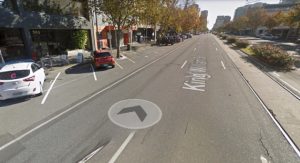Did you know that the State Government intends to upgrade the tramline between South Terrace and Victoria Square? It’s finally going to bring it up to modern disability access standards.
We think that this is an excellent opportunity to also provide safe separated cycling infrastructure on the southern section of King William Street.
The Glenelg Bikeway would have to be one of the most popular cycling routes into the City, but it stops at South Terrace. This already well used route would be even more popular if it provided the 60% of the population who describe themselves as “interested but concerned” with protected cycling all the way to the heart of the City.
The Adelaide City Council’s plans for Victoria Square include a bicycle hub, to encourage people to commute by bike instead of car and leaving bikes, perhaps having a shower, before walking the short remaining distance to their work. How good would that be?
Retailers may fear a separated bike lane would involve some loss of car parking, on which they believe their business depends. But the vast majority of street users (employers, employees, customers) do not park on the street itself and car parking is the least economically productive land use for urban areas.
In fact if well designed, similar to the (now well-received) Frome Bikeway, there would be an important economic benefit for businesses along the street. Certainly the current level of office and retail vacancies indicates that the street needs revitalisation. This is the opportunity to bring this about.
There is plenty of evidence from overseas that demonstrates that cyclist and pedestrian friendly streets are good for business. The Heart Foundation’s Good for Busine$$ (pdf) provides case studies from San Francisco, Washington DC, London and elsewhere indicating the economic benefits of making streets more welcoming for pedestrians and cyclists. (It also provides evidence that local retailers commonly over-estimate the proportion of their customers who arrive by car.)
Perhaps the best-known, most carefully researched evidence is from New York, following the dramatic increase in cyclist infrastructure in the first decade of this century. The city’s Department of Transportation produced a report on the outcomes: The Economic Benefits of Sustainable Streets (pdf). This reveals dramatically increased business compared with comparison sites that did not have the treatment – along with much lower level of injuries for all road users.
Although we don’t have statistical evidence from South Australia, it is obvious that the most prosperous locations in Adelaide are those that are cyclist friendly.
A separated bike lane will encourage customers to the area by providing a buffer to traffic, so reducing noise levels. Using the template provided by Frome Street, it would also beautify the street. Ideally the upgrade would also have the effect of reducing maximum traffic speeds to 40km/h or so, further reducing noise and increasing safety.
Infrastructure matters. Providing separated bikeways is proven to increase rider numbers and reduce car use in increasingly dense cities. Every dollar invested in bikeways saves the community money, especially the health budget. If integrated as a part of the tram stop redevelopment, which will already require a complete street makeover including curb lines, this would deliver savings to tax payers.
How about it, Minister Knoll? How about it, candidates for the ACC elections?

